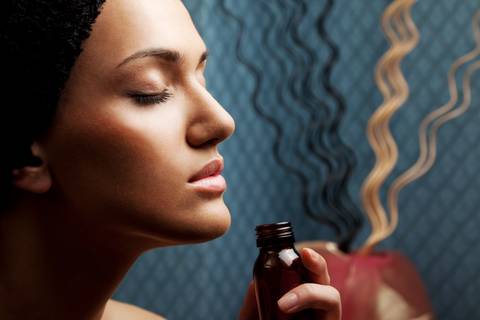Imagine talking with friends and someone in the group says, “What’s that perfume you’re wearing. It’s wonderful.” You smile and say, “It’s a designer perfume I formulated for myself.” Wow! Imagine that. Homemade perfume is made in your kitchen, commercial designer perfumes are created in labs. The only difference is the geography and the experience of the perfumer.
Homemade perfume making is the ultimate art associated with our sense of smell. You can be the artist who is rewarded with awesome fragrances both exotic and simple that are totally unique. Can you imagine the fun you can have as that right brain of yours spins into creative overdrive?
The first step in becoming a perfumer is to develop your nose. That’s what you can do right now. You don’t need to buy one thing to start this process. Here’s what to do:
- If you have any essential oils, line them up on your kitchen counter. Do not remove the lids.
- If you have vanilla, allspice, oil of clove (or any clove spice), anise seed, cinnamon and nutmeg, line them up on your kitchen counter.
- Do you have perfumes or colognes in your house? If so, line them up on the kitchen counter as well.
Now you’re ready to train your nose.
Have ready cotton pads (like those used to remove cosmetics) or small swatches of white cotton fabric, these will be your testers. If you have essential oils, gather together small clean bottles with lids (very clean or your nose will pick up residual odors from your bottles and ruin your test.).
The perfumes
If you have perfumes, spray or apply a few drops of the perfume to one of the testers. Close your eyes and take a whiff. Remove the tester to another room and let it rest for 30 minutes or so. Then close your eyes and take a second whiff. Notice the difference. As the top note (most volatile) elements of the perfume wear off, the middle notes (less volatile) elements will be discernable. Wait another hour or so and then take a third whiff. This time you should be able to smell the base notes (least volatile) constituents of the perfume.
Be patient, it takes time to develop a perfumer’s nose. However, you will eventually be able to smell any perfume, even fresh and discern its constituents. Some perfumers have such refined noses; they can tell you where the ingredients originated. Cool huh?
Essential oils
If you have essential oils, add a few drops of a single essential oil into an odorless carrier oil such as safflower or grapeseed oil. You should never uncap a bottle of essential oil and inhale the oil deeply because these oils are highly concentrated. The essential oil you use may be a top, middle or low note. I’ve provided a short list of the most common oils and their notes which you may find useful. If you blend the essential oils, add the base note first, middle note second, top note last. Gently mix the oils and set aside for several hours to allow them to blend. Then apply the oil to one of your testers and follow the instructions for perfumes above.
- Top Notes: eucalyptus, grapefruit, lemon, lime, tangerine, orange, peppermint, petitgrain, spearmint, sage
- Top to Middle notes: Bergamot, basil, cinnamon (from leaf), Clary sage, coriander, lemongrass, neroli (may also be base note depending on blend), tea tree and thyme
- Middle notes: bay, black pepper, cardamom, chamomile, cypress, geranium, juniper, marjoram, nutmeg, pine, rosemary and yarrow
- Middle to top notes: lavender, fennel, hyssop
- Base notes: cedarwood, clove, frankincense, jasmine, myrrh, patchouli, rose, sandalwood, vanilla, neroli (may be top note depending on blend) and vetiver
- Base to middle notes: ylang ylang, rosewood, cinnamon (from bark), ginger, and cassia
Spices
The spices from your cabinet are to be used as experiments in aroma. Some of them will be powdered, some oils and some, like vanilla may be alcohol based. You can blend them in a variety of ways to train your nose to each unique bouquet. Some aromas you will be very familiar with. See if you can still detect the fragrance of that familiar spice when a small quantity is included in a mixture of other spices. Take mental note as to how the aroma changes over time and how long it lasts. If you blend the spices, pay attention to what you smell at first whiff and any underlying fragrance(s).
Have a lot of fun with this aspect of your homemade perfume training. In future posts, you are going to learn the specifics on creating a perfume. You will also learn more about the concentrations of the various constituents and scent classifications other than the notes. We here at SpaFromScratch think each of our goddesses should be able to have her very own magnificent scent. Why? Because she’s a goddess.
Now go have fun and relax.


Hahaha! Awesome! This year I want to try making perfumes as Christmas presents for the women in my life… ^_^ So excited.
this is way cool